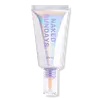Naked Sundays Beautyscreen Peptide Foundation Tint SPF 50 Versus No7 Protect & Perfect Intense Advanced All-In-One Foundation SPF 50+
What's inside
What's inside
 Key Ingredients
Key Ingredients

 Benefits
Benefits

 Concerns
Concerns

 Ingredients Side-by-side
Ingredients Side-by-side

Zinc Oxide 12%
Cosmetic ColorantWater
Skin ConditioningC12-15 Alkyl Benzoate
AntimicrobialButyloctyl Salicylate
Skin ConditioningIsododecane
EmollientLauryl PEG-8 Dimethicone
Iron Oxides
CI 77492
Cosmetic ColorantPropanediol
SolventCI 77491
Cosmetic ColorantCaprylyl Methicone
Skin ConditioningDimethicone
EmollientNiacinamide
SmoothingOctyldodecyl Neopentanoate
EmollientPolymethylsilsesquioxane
Trilaureth-4 Phosphate
EmulsifyingCI 77499
Cosmetic ColorantDimethiconol
EmollientLauryl PEG-10 Tris(Trimethylsiloxy)Silylethyl Dimethicone
EmulsifyingSodium Chloride
MaskingPhenoxyethanol
PreservativeBisabolol
MaskingCaprylyl Glycol
EmollientAllantoin
Skin ConditioningPolyglyceryl-4 Diisostearate/Polyhydroxystearate/Sebacate
EmulsifyingHydrogenated Lecithin
EmulsifyingEthylhexylglycerin
Skin ConditioningHexylene Glycol
EmulsifyingPEG-10
HumectantTetrasodium Glutamate Diacetate
Palmitoyl Pentapeptide-4
Skin ConditioningSqualane
EmollientSodium Hydroxide
BufferingTitanium Dioxide
Cosmetic ColorantPolyglutamic Acid
Skin ConditioningAluminum Hydroxide
EmollientZinc Oxide 12%, Water, C12-15 Alkyl Benzoate, Butyloctyl Salicylate, Isododecane, Lauryl PEG-8 Dimethicone, Iron Oxides, CI 77492, Propanediol, CI 77491, Caprylyl Methicone, Dimethicone, Niacinamide, Octyldodecyl Neopentanoate, Polymethylsilsesquioxane, Trilaureth-4 Phosphate, CI 77499, Dimethiconol, Lauryl PEG-10 Tris(Trimethylsiloxy)Silylethyl Dimethicone, Sodium Chloride, Phenoxyethanol, Bisabolol, Caprylyl Glycol, Allantoin, Polyglyceryl-4 Diisostearate/Polyhydroxystearate/Sebacate, Hydrogenated Lecithin, Ethylhexylglycerin, Hexylene Glycol, PEG-10, Tetrasodium Glutamate Diacetate, Palmitoyl Pentapeptide-4, Squalane, Sodium Hydroxide, Titanium Dioxide, Polyglutamic Acid, Aluminum Hydroxide
Water
Skin ConditioningCyclopentasiloxane
EmollientCaprylyl Methicone
Skin ConditioningGlycerin
HumectantButylene Glycol
HumectantPEG-9 Dimethicone
Skin ConditioningTrimethylsiloxysilicate
EmollientHdi/Trimethylol Hexyllactone Crosspolymer
Bis-Isobutyl PEG/PPG-10/7/Dimethicone Copolymer
EmulsifyingDisteardimonium Hectorite
StabilisingCyclohexasiloxane
EmollientMica
Cosmetic ColorantMagnesium Sulfate
Phenoxyethanol
PreservativeSilica
AbrasiveAlcohol Denat.
AntimicrobialPropylene Carbonate
SolventTriethoxycaprylylsilane
Methylparaben
PreservativePropylene Glycol
HumectantTocopheryl Acetate
AntioxidantDimethicone
EmollientAscorbyl Glucoside
AntioxidantEthylparaben
PreservativeRetinyl Palmitate
Skin ConditioningTetrasodium EDTA
Sorbitan Laurate
EmulsifyingPanax Ginseng Root Extract
EmollientCarbomer
Emulsion StabilisingPotassium Hydroxide
BufferingDimethylmethoxy Chromanol
AntioxidantPolysorbate 20
EmulsifyingTocopherol
AntioxidantHydroxyethylcellulose
Emulsion StabilisingAcetyl Dipeptide-1 Cetyl Ester
Skin ConditioningMorus Alba Leaf Extract
Skin ConditioningBHT
AntioxidantPalmitoyl Tripeptide-1
Skin ConditioningPalmitoyl Tetrapeptide-7
Skin ConditioningCI 77891
Cosmetic ColorantCI 77492
Cosmetic ColorantCI 77491
Cosmetic ColorantCI 77499
Cosmetic ColorantWater, Cyclopentasiloxane, Caprylyl Methicone, Glycerin, Butylene Glycol, PEG-9 Dimethicone, Trimethylsiloxysilicate, Hdi/Trimethylol Hexyllactone Crosspolymer, Bis-Isobutyl PEG/PPG-10/7/Dimethicone Copolymer, Disteardimonium Hectorite, Cyclohexasiloxane, Mica, Magnesium Sulfate, Phenoxyethanol, Silica, Alcohol Denat., Propylene Carbonate, Triethoxycaprylylsilane, Methylparaben, Propylene Glycol, Tocopheryl Acetate, Dimethicone, Ascorbyl Glucoside, Ethylparaben, Retinyl Palmitate, Tetrasodium EDTA, Sorbitan Laurate, Panax Ginseng Root Extract, Carbomer, Potassium Hydroxide, Dimethylmethoxy Chromanol, Polysorbate 20, Tocopherol, Hydroxyethylcellulose, Acetyl Dipeptide-1 Cetyl Ester, Morus Alba Leaf Extract, BHT, Palmitoyl Tripeptide-1, Palmitoyl Tetrapeptide-7, CI 77891, CI 77492, CI 77491, CI 77499
Ingredients Explained
These ingredients are found in both products.
Ingredients higher up in an ingredient list are typically present in a larger amount.
Caprylyl Methicone is a type of silicone.
It helps soften and soothe the skin by creating a thin film on top. This film helps trap moisture, keeping your skin hydrated.
Ci 77491 is also hydrated iron III oxide. It's sole purpose is to give a red/pink hue to products.
Iron III oxides are classified as inorganic chemicals for coloring.
Synthetically created Ci 77491 is considered safer than those naturally found. This is because the synthetically created version may contain less impurities. Iron oxides are generally non-toxic and non-allergenic.
Learn more about CI 77491Ci 77492 is also hydrated iron III oxide. It's sole purpose is to give a yellow hue to products.
Iron III oxides are classified as inorganic chemicals for coloring.
Synthetically created Ci 77492 is considered safer than those naturally found. This is because the synthetically created version may contain less impurities. Iron oxides are generally non-toxic and non-allergenic.
Learn more about CI 77492Ci 77499 is also hydrated iron III oxide. It is created from mixing red and black iron oxides. This helps give shades of darkness to a product.
Iron III oxides are classified as inorganic chemicals for coloring.
Dimethicone is a type of synthetic silicone created from natural materials such as quartz.
What it does:
Dimethicone comes in different viscosities:
Depending on the viscosity, dimethicone has different properties.
Ingredients lists don't always show which type is used, so we recommend reaching out to the brand if you have questions about the viscosity.
This ingredient is unlikely to cause irritation because it does not get absorbed into skin. However, people with silicone allergies should be careful about using this ingredient.
Note: Dimethicone may contribute to pilling. This is because it is not oil or water soluble, so pilling may occur when layered with products. When mixed with heavy oils in a formula, the outcome is also quite greasy.
Learn more about DimethiconePhenoxyethanol is a preservative that has germicide, antimicrobial, and aromatic properties. Studies show that phenoxyethanol can prevent microbial growth. By itself, it has a scent that is similar to that of a rose.
It's often used in formulations along with Caprylyl Glycol to preserve the shelf life of products.
Water. It's the most common cosmetic ingredient of all. You'll usually see it at the top of ingredient lists, meaning that it makes up the largest part of the product.
So why is it so popular? Water most often acts as a solvent - this means that it helps dissolve other ingredients into the formulation.
You'll also recognize water as that liquid we all need to stay alive. If you see this, drink a glass of water. Stay hydrated!
Learn more about Water